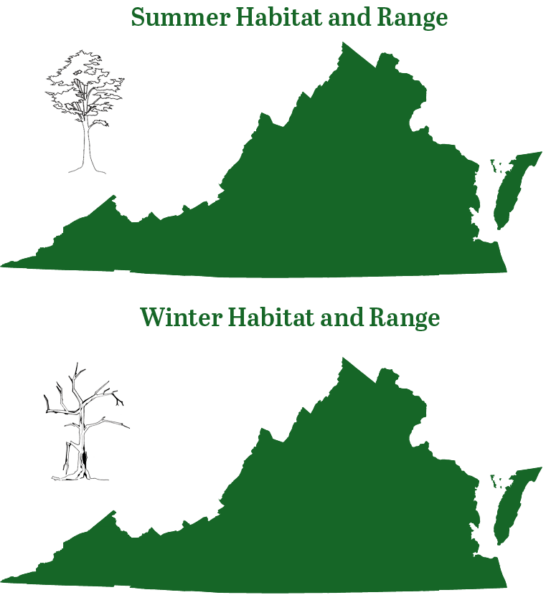Eastern Red Bat. © Merlin D. Tuttle, Bat Conservation International.
Eastern Red Bat. Illustration by Brittany Fernald.
Fact File
Scientific Name: Lasiurus borealis
Classification: Mammal, Order Chiroptera
Conservation Status:
- Species of Greatest Conservation Need-Tier 4a on the Virginia Wildlife Action Plan
Identifying Characteristics
The eastern red bat (“red bat”) is Virginia’s most common tree bat. Adults measure approximately 3.75–4.5 inches in length and weigh 0.2–0.5 ounces. The red bat is easily distinguished from all other bats in Virginia by its unique red color and furred tail. This is the only species in Virginia that is “sexually dimorphic” (you can distinguish males from females by fur color). Males are a bright “Irish setter red” while females have a frosting of white that gives them a duller look. Their ears are short and rounded and the tragus is triangular in shape. Both males and females have a white patch of fur on their shoulders and wrists.
Habitat
The red bat roosts in trees during both summer and winter. In the summer, females raise their young in dense foliage in the branches of trees. During winter, they hibernate in tree cavities or under logs or rocks. It is not uncommon for logging operators to find red bats under log piles during the winter.
Diet
Red bats can be found feeding around lights in urban, suburban, or country settings. Moths and beetles comprise a large portion of their diet along with June bugs, planthoppers, ants, and leafhoppers.
Distribution:
The eastern red bat is found throughout Virginia and typically migrate in the fall from their northern summer range to winter in the south.

Maternity
Reproduction occurs in late summer before the bats start their migration. Copulation occurs during flight, and delayed fertilization occurs in the spring. While most bats have one or at most two young, the red bat can produce up to four young, and there is a record of one female having five young. Indeed, bats of this genus (Lasiurus) possess four functional mammae, unlike other bats which possess only two. Like other temperate bats, a single litter is produced in late spring or early summer.
Conservation
Wind energy development is the primary threat to this species. Wind turbine operational adjustments or development of acoustic deterrents are conservation priorities.
Last updated: August 14, 2024
ShopDWR
Order your copy of A Guide to the Bats of Virginia, along with more gear, guides, and gifts!
Visit ShopDWRThe Virginia Department of Wildlife Resources Species Profile Database serves as a repository of information for Virginia’s fish and wildlife species. The database is managed and curated by the Wildlife Information and Environmental Services (WIES) program. Species profile data, distribution information, and photography is generated by the Virginia Department of Wildlife Resources, State and Federal agencies, Collection Permittees, and other trusted partners. This product is not suitable for legal, engineering, or surveying use. The Virginia Department of Wildlife Resources does not accept responsibility for any missing data, inaccuracies, or other errors which may exist. In accordance with the terms of service for this product, you agree to this disclaimer.

